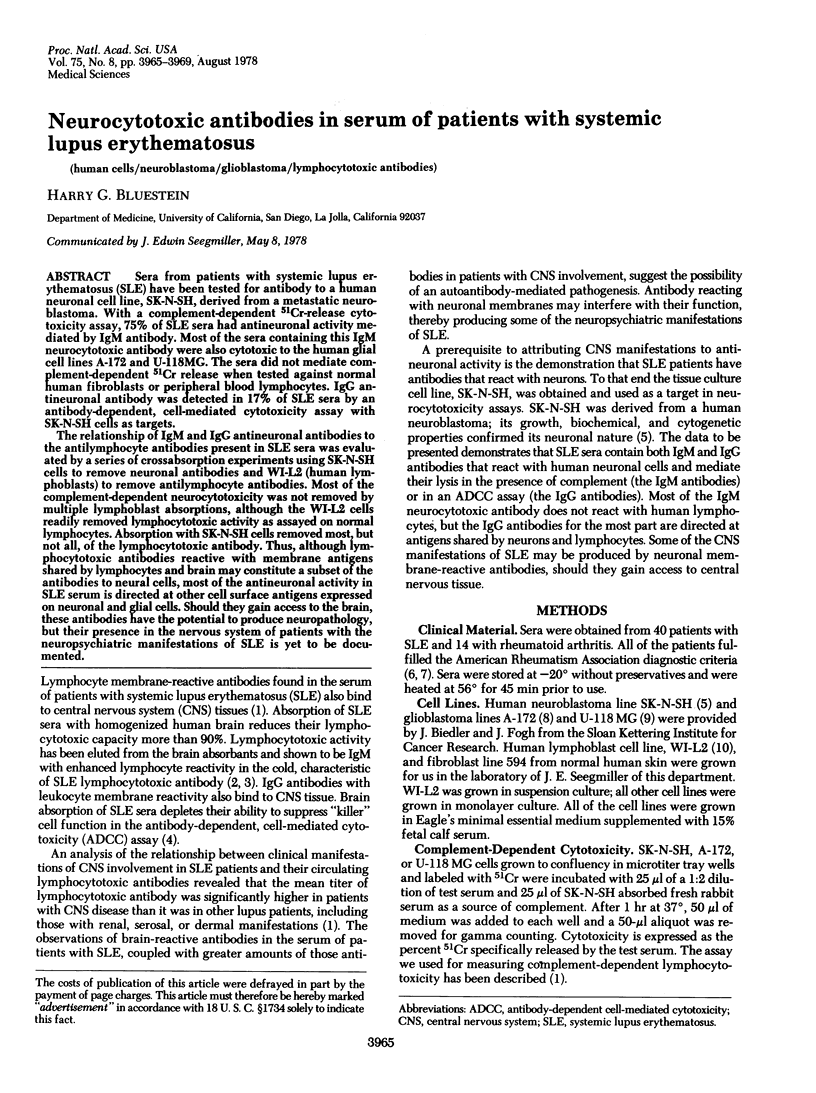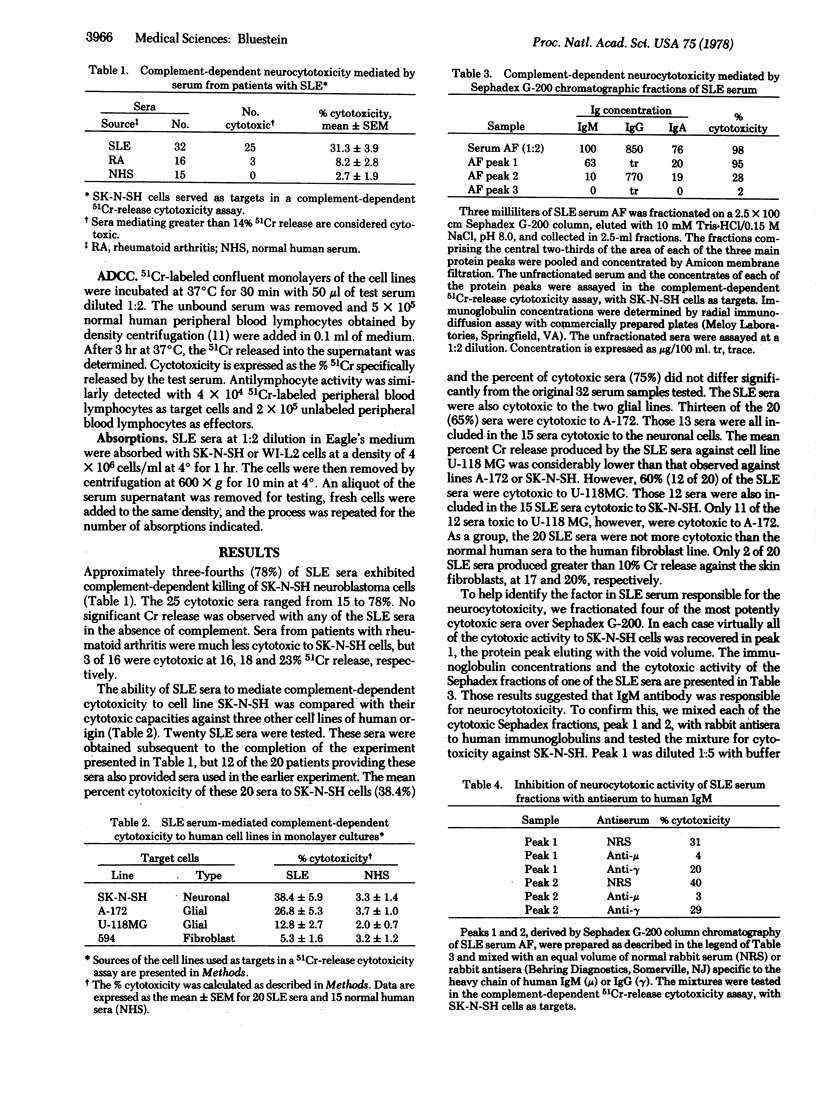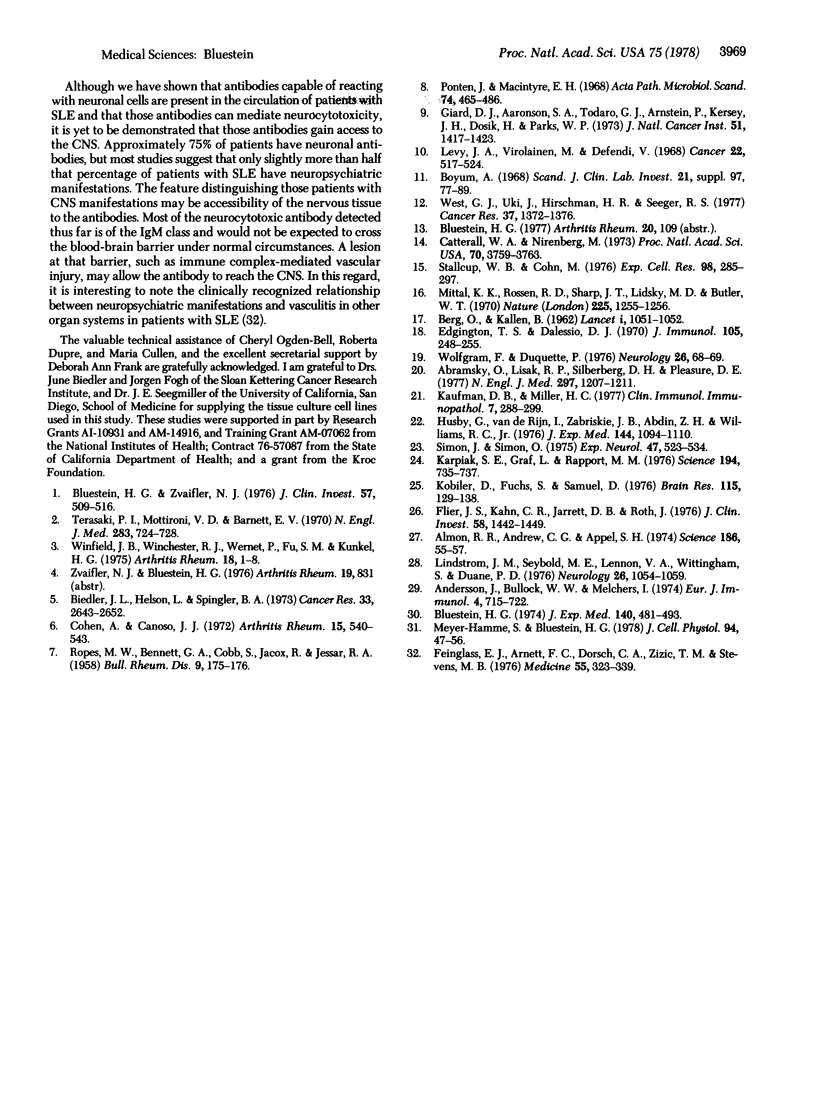Abstract
Sera from patients with systemic lupus erythematosus (SLE) have been tested for antibody to a human neuronal cell line, SK-N-SH, derived from a metastatic neuroblastoma. With a complement-dependent 51Cr-release cytotoxicity assay, 75% of SLE sera had antineuronal activity mediated by IgM antibody. Most of the sera containing this IgM neurocytotoxic antibody were also cytotoxic to the human glial cell lines A-172 and U-118MG. The sera did not mediate complement-dependent 51Cr release when tested against normal human fibroblasts or peripheral blood lymphocytes. IgG antineuronal antibody was detected in 17% of SLE sera by an antibody-dependent, cell-mediated cytotoxicity assay with SK-N-SH cells as targets.
The relationship of IgM and IgG antineuronal antibodies to the antilymphocyte antibodies present in SLE sera was evaluated by a series of crossabsorption experiments using SK-N-SH cells to remove neuronal antibodies and WI-L2 (human lymphoblasts) to remove antilymphocyte antibodies. Most of the complement-dependent neurocytotoxicity was not removed by multiple lymphoblast absorptions, although the WI-L2 cells readily removed lymphocytotoxic activity as assayed on normal lymphocytes. Absorption with SK-N-SH cells removed most, but not all, of the lymphocytotoxic antibody. Thus, although lymphocytotoxic antibodies reactive with membrane antigens shared by lymphocytes and brain may constitute a subset of the antibodies to neural cells, most of the antineuronal activity in SLE serum is directed at other cell surface antigens expressed on neuronal and glial cells. Should they gain access to the brain, these antibodies have the potential to produce neuropathology, but their presence in the nervous system of patients with the neuropsychiatric manifestations of SLE is yet to be documented.
Keywords: human cells, neuroblastoma, glioblastoma, lymphocytotoxic antibodies
Full text
PDF




Selected References
These references are in PubMed. This may not be the complete list of references from this article.
- Abramsky O., Lisak R. P., Silberberg D. H., Pleasure D. E. Antibodies to oligodendroglia in patients with multiple sclerosis. N Engl J Med. 1977 Dec 1;297(22):1207–1211. doi: 10.1056/NEJM197712012972204. [DOI] [PubMed] [Google Scholar]
- Almon R. R., Andrew C. G., Appel S. H. Serum globulin in myasthenia gravis: inhibition of alpha-bungarotoxin binding to acetylcholine receptors. Science. 1974 Oct 4;186(4158):55–57. doi: 10.1126/science.186.4158.55. [DOI] [PubMed] [Google Scholar]
- Andersson J., Bullock W. W., Melchers F. Inhibition of mitogenic stimulation of mouse lymphocytes by anti-mouse immunoglobulin antibodies. I. Mode of action. Eur J Immunol. 1974 Nov;4(11):715–722. doi: 10.1002/eji.1830041103. [DOI] [PubMed] [Google Scholar]
- BERG O., KALLEN B. Gliotoxic effect of serum from patients with neurological diseases. Lancet. 1962 May 19;1(7238):1051–1052. doi: 10.1016/s0140-6736(62)92148-7. [DOI] [PubMed] [Google Scholar]
- Biedler J. L., Helson L., Spengler B. A. Morphology and growth, tumorigenicity, and cytogenetics of human neuroblastoma cells in continuous culture. Cancer Res. 1973 Nov;33(11):2643–2652. [PubMed] [Google Scholar]
- Bluestein H. G. Alloantiserum-mediated suppression of histocompatibility-linked Ir-gene-controlled immune responses. Suppressive effects of IgG fragments derived from alloantisera. J Exp Med. 1974 Aug 1;140(2):481–493. doi: 10.1084/jem.140.2.481. [DOI] [PMC free article] [PubMed] [Google Scholar]
- Bluestein H. G., Zvaifler N. J. Brain-reactive lymphocytotoxic antibodies in the serum of patients with systemic lupus erythematosus. J Clin Invest. 1976 Feb;57(2):509–516. doi: 10.1172/JCI108303. [DOI] [PMC free article] [PubMed] [Google Scholar]
- Böyum A. Isolation of mononuclear cells and granulocytes from human blood. Isolation of monuclear cells by one centrifugation, and of granulocytes by combining centrifugation and sedimentation at 1 g. Scand J Clin Lab Invest Suppl. 1968;97:77–89. [PubMed] [Google Scholar]
- Catterall W. A., Nirenberg M. Sodium uptake associated with activation of action potential ionophores of cultured neuroblastoma and muscle cells. Proc Natl Acad Sci U S A. 1973 Dec;70(12):3759–3763. doi: 10.1073/pnas.70.12.3759. [DOI] [PMC free article] [PubMed] [Google Scholar]
- Cohen A. S., Canoso J. J. Criteria for the classification of systemic lupus erythematosus--status 1972. Arthritis Rheum. 1972 Sep-Oct;15(5):540–543. doi: 10.1002/art.1780150512. [DOI] [PubMed] [Google Scholar]
- Edgington T. S., Dalessio D. J. The assessment by immunofluorescence methods of humoral anti-myelin antibodies in man. J Immunol. 1970 Jul;105(1):248–255. [PubMed] [Google Scholar]
- Feinglass E. J., Arnett F. C., Dorsch C. A., Zizic T. M., Stevens M. B. Neuropsychiatric manifestations of systemic lupus erythematosus: diagnosis, clinical spectrum, and relationship to other features of the disease. Medicine (Baltimore) 1976 Jul;55(4):323–339. doi: 10.1097/00005792-197607000-00004. [DOI] [PubMed] [Google Scholar]
- Flier J. S., Kahn C. R., Jarrett D. B., Roth J. Characterization of antibodies to the insulin receptor: a cause of insulin-resistant diabetes in man. J Clin Invest. 1976 Dec;58(6):1442–1449. doi: 10.1172/JCI108600. [DOI] [PMC free article] [PubMed] [Google Scholar]
- Giard D. J., Aaronson S. A., Todaro G. J., Arnstein P., Kersey J. H., Dosik H., Parks W. P. In vitro cultivation of human tumors: establishment of cell lines derived from a series of solid tumors. J Natl Cancer Inst. 1973 Nov;51(5):1417–1423. doi: 10.1093/jnci/51.5.1417. [DOI] [PubMed] [Google Scholar]
- Husby G., van de Rijn I., Zabriskie J. B., Abdin Z. H., Williams R. C., Jr Antibodies reacting with cytoplasm of subthalamic and caudate nuclei neurons in chorea and acute rheumatic fever. J Exp Med. 1976 Oct 1;144(4):1094–1110. doi: 10.1084/jem.144.4.1094. [DOI] [PMC free article] [PubMed] [Google Scholar]
- Karpiak S. E., Graf L., Rapport M. M. Antiserum to brain gangliosides produces recurrent epileptiform activity. Science. 1976 Nov 12;194(4266):735–737. doi: 10.1126/science.982041. [DOI] [PubMed] [Google Scholar]
- Kaufman D. B., Miller H. C. A taxia telangiectasia: an autoimmune disease associated with a cytotoxic antibody to brain and thymus. Clin Immunol Immunopathol. 1977 Mar;7(2):288–299. doi: 10.1016/0090-1229(77)90056-3. [DOI] [PubMed] [Google Scholar]
- Kobiler D., Fuchs S., Samuel D. The effect of antisynaptosomal plasma membrane antibodies on memory. Brain Res. 1976 Oct 8;115(1):129–138. doi: 10.1016/0006-8993(76)90827-1. [DOI] [PubMed] [Google Scholar]
- Levy J. A., Virolainen M., Defendi V. Human lymphoblastoid lines from lymph node and spleen. Cancer. 1968 Sep;22(3):517–524. doi: 10.1002/1097-0142(196809)22:3<517::aid-cncr2820220305>3.0.co;2-a. [DOI] [PubMed] [Google Scholar]
- Lindstrom J. M., Seybold M. E., Lennon V. A., Whittingham S., Duane D. D. Antibody to acetylcholine receptor in myasthenia gravis. Prevalence, clinical correlates, and diagnostic value. Neurology. 1976 Nov;26(11):1054–1059. doi: 10.1212/wnl.26.11.1054. [DOI] [PubMed] [Google Scholar]
- Mittal K. K., Rossen R. D., Sharp J. T., Lidsky M. D., Butler W. T. Lymphocyte cytotoxic antibodies in systemic lupus erythematosus. Nature. 1970 Mar 28;225(5239):1255–1256. doi: 10.1038/2251255a0. [DOI] [PubMed] [Google Scholar]
- Pontén J., Macintyre E. H. Long term culture of normal and neoplastic human glia. Acta Pathol Microbiol Scand. 1968;74(4):465–486. doi: 10.1111/j.1699-0463.1968.tb03502.x. [DOI] [PubMed] [Google Scholar]
- ROPES M. W., BENNETT G. A., COBB S., JACOX R., JESSAR R. A. 1958 Revision of diagnostic criteria for rheumatoid arthritis. Bull Rheum Dis. 1958 Dec;9(4):175–176. [PubMed] [Google Scholar]
- Simon J., Simon O. Effect of passive transfer of anti-brain antibodies to a normal recipient. Exp Neurol. 1975 Jun;47(3):523–534. doi: 10.1016/0014-4886(75)90085-0. [DOI] [PubMed] [Google Scholar]
- Stallcup W. B., Cohn M. Correlation of surface antigens and cell type in cloned cell lines from the rat central nervous system. Exp Cell Res. 1976 Mar 15;98(2):285–297. doi: 10.1016/0014-4827(76)90440-7. [DOI] [PubMed] [Google Scholar]
- Terasaki P. I., Mottironi V. D., Barnett E. V. Cytotoxins in disease. Autocytotoxins in lupus. N Engl J Med. 1970 Oct 1;283(14):724–728. doi: 10.1056/NEJM197010012831403. [DOI] [PubMed] [Google Scholar]
- West G. J., Uki J., Herschman H. R., Seeger R. C. Adrenergic, cholinergic, and inactive human neuroblastoma cell lines with the action-potential Na+ ionophore. Cancer Res. 1977 May;37(5):1372–1376. [PubMed] [Google Scholar]
- Winfield J. B., Winchester R. J., Wernet P., Fu S. M., Kunkel H. G. Nature of cold-reactive antibodies to lymphocyte surface determinants in systemic lupus erythematosus. Arthritis Rheum. 1975 Jan-Feb;18(1):1–8. doi: 10.1002/art.1780180101. [DOI] [PubMed] [Google Scholar]
- Wolfgram F., Duquette P. Demyelinating antibodies in multiple sclerosis. Neurology. 1976 Jun;26(6 Pt 2):68–69. doi: 10.1212/wnl.26.6_part_2.68. [DOI] [PubMed] [Google Scholar]


